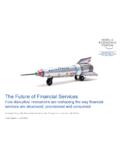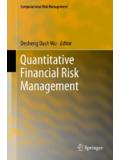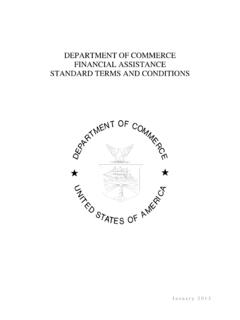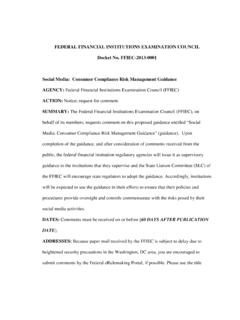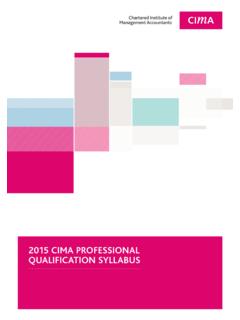Transcription of Basel Committee on Banking Supervision
1 Basel Committee on Banking Supervision Operational Risk Supervisory Guidelines for the advanced Measurement Approaches June 2011 Copies of publications are available from: Bank for International Settlements Communications CH-4002 Basel , Switzerland E-mail: Fax: +41 61 280 9100 and +41 61 280 8100 Bank for International Settlements 2011. All rights reserved. Brief excerpts may be reproduced or translated provided the source is stated. ISBN print: 92-9131-856-6 ISBN web: 92-9197-856-6 Members of the SIG Operational Risk Subgroup Chairman: Mitsutoshi Adachi, Bank of Japan Australian Prudential Regulation Authority Michael Booth National Bank of Belgium Jos Meuleman Banco Central do Brasil, Brazil Wagner Almeida Office of the Superintendent of Financial Institutions, Canada James Dennison Aina Liepins China Banking Regulatory Commission Meng Luo Banque de France Jean-Luc Qu mard Deutsche Bundesbank, Germany Marcus Haas Federal Financial Supervisory Authority (BaFin)
2 , Germany Frank Corleis Reserve Bank of India Rajinder Kumar Bank of Italy Marco Moscadelli Bank of Japan Madoka Miyamura Financial Services Agency, Japan Tsuyoshi Nagafuji Surveillance Commission for the Financial Sector, Luxembourg Didier Bergamo Netherlands Bank Claudia Zapp Polish Financial Supervision Authority Grazyna Szwajkowska Central Bank of the Russian Federation Irina Yakimova South African Reserve Bank Jan van Zyl Bank of Spain Mar a ngeles Nieto Finansinspektionen, Sweden Agnieszka Arshamian Swiss Financial Market Supervisory Authority Paul Harpes Financial Services Authority, United Kingdom Andrew Sheen Khim Murphy Federal Deposit Insurance Corporation.
3 United States Alfred Seivold Federal Reserve Board, United States Adrienne Townes Haden Kenneth G. Fulton Federal Reserve Bank of Boston, United States Patrick de Fontnouvelle Federal Reserve Bank of New York, United States Ronald Stroz Office of the Comptroller of the Currency, United States Carolyn DuChene Maurice Harris Office of Thrift Supervision , United States Eric Hirschhorn Financial Stability Institute Amarendra Mohan Secretariat of the Basel Committee on Banking Andrew Willis Supervision , Bank for International Settlements Operational Risk Supervisory Guidelines for the advanced Measurement Approaches Table of Contents Introduction.
4 1 Governance ..11 Verification and validation ..11 Use test and Data ..20 Gross loss definition ..20 Gross versus net internal loss amounts ..23 Internal loss data thresholds ..25 Date of internal losses ..27 Grouped losses ..30 Modelling ..34 Granularity ..34 Distributional assumptions ..36 Correlation and dependence ..43 Use of the four data elements ..45 Operational Risk Supervisory Guidelines for the advanced Measurement Approaches Introduction 1. The Basel Committee s Standards Implementation Group, through its Operational Risk Subgroup (SIGOR), has focused on the practical challenges associated with the development, implementation and maintenance of an operational risk (OR) management and measurement framework that meets the requirements of Basel II,1 particularly as they relate to the advanced Measurement Approaches (AMA). The SIGOR s mandate includes identifying and participating in resolving the practical challenges associated with the successful development, implementation and maintenance of an AMA framework.
5 2. Consistent with this mandate, this paper identifies supervisory guidelines associated with the development and maintenance of key internal governance, data and modelling frameworks underlying an AMA. Because operational risk is an evolving discipline, this paper is intended to be an evergreen document, and as further issues are identified and expectations for convergence towards a narrower range of appropriate practices are developed, these too will be added to this document. 3. This paper does not reduce or supersede the discretion of national supervisors to act in a manner that is consistent with their particular regulatory approaches. Nevertheless, the publication of this paper is intended to facilitate a convergence of practice by banks as well as national supervisors. Background 4. In the development of the Basel II Framework, the fundamental objective of the Basel Committee on Banking Supervision was to develop a framework that would further strengthen the soundness and stability of the international Banking system while maintaining sufficient consistency so that capital adequacy regulation would not be a significant source of competitive inequality among internationally active banks.
6 The capital regulation was also designed to take into account changes in Banking and risk management practices while at the same time preserving the benefits of a framework that can be applied as uniformly as possible at the international level. 5. In recognition of the evolutionary nature of operational risk management as a developing risk management discipline, the Committee provided significant flexibility to banks in the development of an operational risk measurement and management system. This flexibility was, and continues to be, a critical feature of the AMA. These features, however, require substantial efforts by national authorities to ensure sufficient consistency in application. 6. Flexibility in the development of an AMA, however, does not suggest that supervisors are prepared to accept any practice or process that a bank adopts in implementing its AMA frameworks.
7 On the contrary, supervisors are concerned with 1 Basel II Framework and Basel II , used interchangeably in this report, refer to the Basel Committee s International Convergence of Capital Measurement and Capital Standards: A Revised Framework (June 2006). Operational Risk Supervisory Guidelines for the advanced Measurement Approaches 1 identifying and encouraging bank operational risk practices that achieve robust and effective operational risk management and measurement systems that are consistent with safety, soundness and level playing field objectives. General observations 7. The Basel II Framework envisages that, over time, the operational risk discipline will mature and converge towards a narrower band of effective risk management and risk measurement practices. Understanding the current range of observed operational risk management and measurement practices, both within and across geographic regions, contributes significantly to the efforts to establish consistent supervisory expectations.
8 Through the analysis of existing practices, and the publication of this paper, the Committee expects the maturation of operational risk practices and supports supervisors in developing more consistent regulatory expectations. As part of this process, the Committee has identified practices that fall outside the range of effective and sound operational risk practices. 8. Irrespective of the risk management and risk measurement practices adopted, a bank s operational risk strategy should reflect the nature and source of the bank s operational risks for all Operational Risk Measurement System (ORMS) elements, including regular review of predictive elements against experience. The operational risk strategy should be current and reflect material changes to the internal and external environment. Risk reporting should provide a clear understanding of the key operational risks, the related drivers and the effectiveness of the internal controls.
9 The internal reporting framework should include regular reporting of relevant information at all levels of the bank, be transparent, responsive to changes, appropriate and support the proactive management of operational risk. Industry trends and practices 9. In July 2009, the Committee published two papers providing current information on the operational risk data and practices of institutions implementing Basel II, The 2008 Loss Data Collection Exercise (LDCE Paper) and the Observed range of practice in key elements of the advanced Measurement Approaches (AMA) (Range of Practice Paper).2 These papers were designed to advance SIGOR s goal of promoting consistency in implementation of the Basel II Framework by furthering the understanding of both supervisors and participating Banking institutions regarding outstanding operational risk implementation issues, as well as to foster consistency in addressing these issues across regions.
10 10. The LDCE was the first international loss data collection effort to collect information on all four data elements that are used in the AMA. The main findings of the LDCE Paper were: (a) Overall, banks have made considerable progress in the collection and use of internal loss data since the previous international LDCE, conducted in 2002; (b) The frequency of internal losses of 20,000 or more varies significantly across regions when the data are scaled by various exposure indicators; (d) Despite the regional variation in loss frequency noted above, there is some consistency in the severity distribution of operational losses across regions; 2 These papers are available at 2 Operational Risk Supervisory Guidelines for the advanced Measurement Approaches (e) Most banks' scenario data extends the tail of the loss distribution beyond the point at which they have experienced internal losses.













